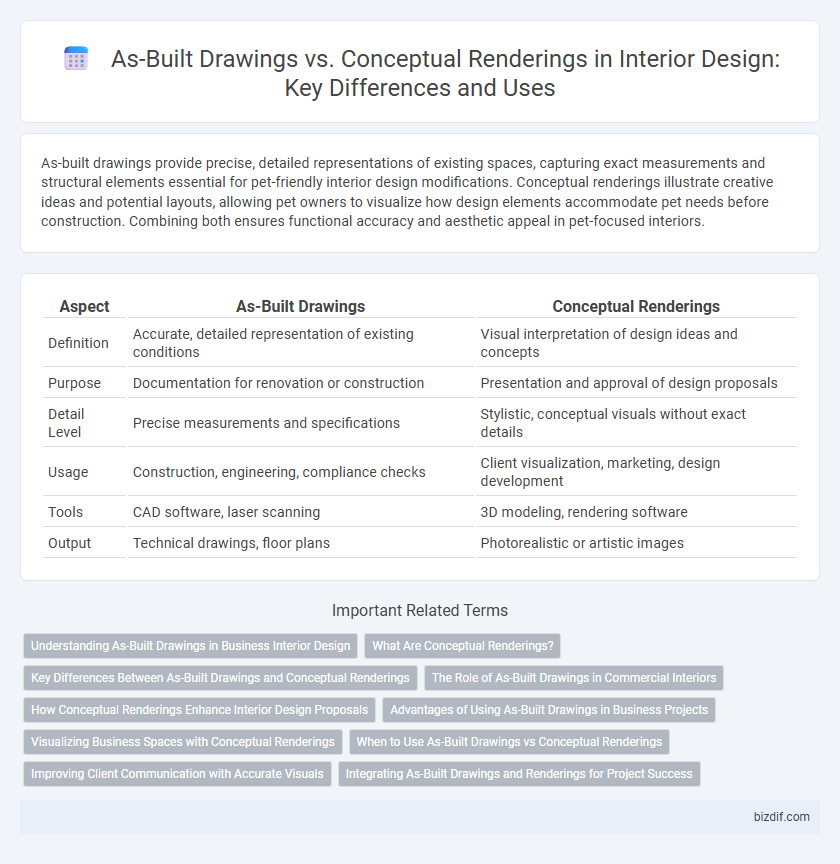As-built drawings provide precise, detailed representations of existing spaces, capturing exact measurements and structural elements essential for pet-friendly interior design modifications. Conceptual renderings illustrate creative ideas and potential layouts, allowing pet owners to visualize how design elements accommodate pet needs before construction. Combining both ensures functional accuracy and aesthetic appeal in pet-focused interiors.
Table of Comparison
| Aspect | As-Built Drawings | Conceptual Renderings |
|---|---|---|
| Definition | Accurate, detailed representation of existing conditions | Visual interpretation of design ideas and concepts |
| Purpose | Documentation for renovation or construction | Presentation and approval of design proposals |
| Detail Level | Precise measurements and specifications | Stylistic, conceptual visuals without exact details |
| Usage | Construction, engineering, compliance checks | Client visualization, marketing, design development |
| Tools | CAD software, laser scanning | 3D modeling, rendering software |
| Output | Technical drawings, floor plans | Photorealistic or artistic images |
Understanding As-Built Drawings in Business Interior Design
As-built drawings provide an accurate record of a business interior's current structural and spatial conditions, ensuring precise documentation for renovation or retrofit projects. These detailed plans capture modifications made during construction, offering critical information for contractors and designers to avoid costly errors. Understanding as-built drawings is essential for effective space planning, compliance with building codes, and seamless integration of new design elements in commercial environments.
What Are Conceptual Renderings?
Conceptual renderings in interior design are detailed visualizations that illustrate the proposed aesthetic, spatial layout, and material finishes of a space before construction begins. They provide an immersive representation of design ideas using 3D modeling and computer-generated imagery to help clients and designers visualize the end result. These renderings enable informed decisions regarding color schemes, furniture placement, and lighting, aligning expectations with the intended design vision.
Key Differences Between As-Built Drawings and Conceptual Renderings
As-built drawings provide precise, detailed documentation of a completed interior space, including exact measurements and existing conditions critical for renovation or maintenance. Conceptual renderings offer visual representations emphasizing design intent, aesthetic appeal, and spatial relationships without detailed technical specifications. The key differences lie in their purpose: as-built drawings serve accuracy and compliance, while conceptual renderings focus on creativity and client visualization.
The Role of As-Built Drawings in Commercial Interiors
As-built drawings provide precise, updated documentation of the actual dimensions and conditions of a commercial interior space, ensuring accuracy for renovation or remodeling projects. These drawings serve as a critical reference for contractors, architects, and designers to avoid costly errors and facilitate compliance with building codes and regulations. Unlike conceptual renderings, which illustrate design intent and aesthetics, as-built drawings focus on the exact physical realities essential for successful commercial interior execution.
How Conceptual Renderings Enhance Interior Design Proposals
Conceptual renderings provide vivid, photorealistic visuals that bring interior design proposals to life, enabling clients to better understand spatial layouts, color schemes, and material choices. These digital visualizations facilitate informed decision-making, reducing costly revisions during the implementation phase. Unlike as-built drawings that document existing conditions, conceptual renderings inspire creativity and convey design intent with accuracy and emotional impact.
Advantages of Using As-Built Drawings in Business Projects
As-built drawings provide precise and accurate documentation of the existing conditions of a space, enabling interior design professionals to make informed decisions and avoid costly errors during project execution. These drawings facilitate effective communication among architects, contractors, and clients by offering a reliable reference that reflects the actual dimensions and materials used. Utilizing as-built drawings in business projects enhances project efficiency, reduces rework, and ensures alignment with design intents and regulatory requirements.
Visualizing Business Spaces with Conceptual Renderings
Conceptual renderings offer a dynamic visualization of business spaces by providing detailed, realistic images that highlight design aesthetics and spatial functionality. Unlike as-built drawings that document existing structural conditions, conceptual renderings enable designers and stakeholders to explore creative possibilities and make informed decisions before construction. These visual tools enhance communication, ensuring alignment on design intent and facilitating smoother project execution in commercial interior design.
When to Use As-Built Drawings vs Conceptual Renderings
As-built drawings provide precise, detailed representations of existing conditions and structural elements, essential during renovation, construction phases, or verifying compliance with design specifications. Conceptual renderings serve to visualize design ideas, spatial layouts, and aesthetic concepts, making them invaluable in early project stages for client approval and design iteration. Use as-built drawings when accuracy and technical validation are required, whereas conceptual renderings are best for exploring and communicating creative design visions.
Improving Client Communication with Accurate Visuals
As-built drawings provide precise measurements and detailed documentation of the existing space, ensuring all modifications and structural elements are accurately captured for reference and future planning. Conceptual renderings offer visually engaging, three-dimensional representations that help clients visualize design intent and spatial arrangements before construction begins. Utilizing both tools enhances client communication by marrying technical accuracy with artistic interpretation, reducing misunderstandings and aligning expectations effectively throughout the interior design process.
Integrating As-Built Drawings and Renderings for Project Success
Integrating as-built drawings with conceptual renderings enhances accuracy by providing precise, up-to-date measurements that inform detailed design visuals, ensuring client expectations align with spatial realities. Using as-built data to refine renderings minimizes costly modifications during construction, streamlines project timelines, and improves communication among architects, designers, and contractors. This synergy promotes efficient decision-making and results in cohesive, functional interior spaces tailored to exact specifications.
As-built drawings vs Conceptual renderings Infographic

 bizdif.com
bizdif.com